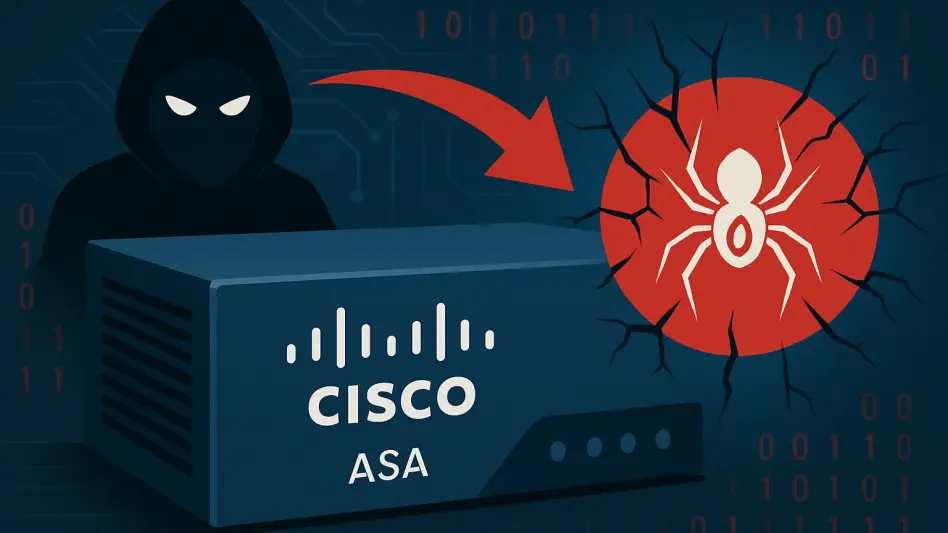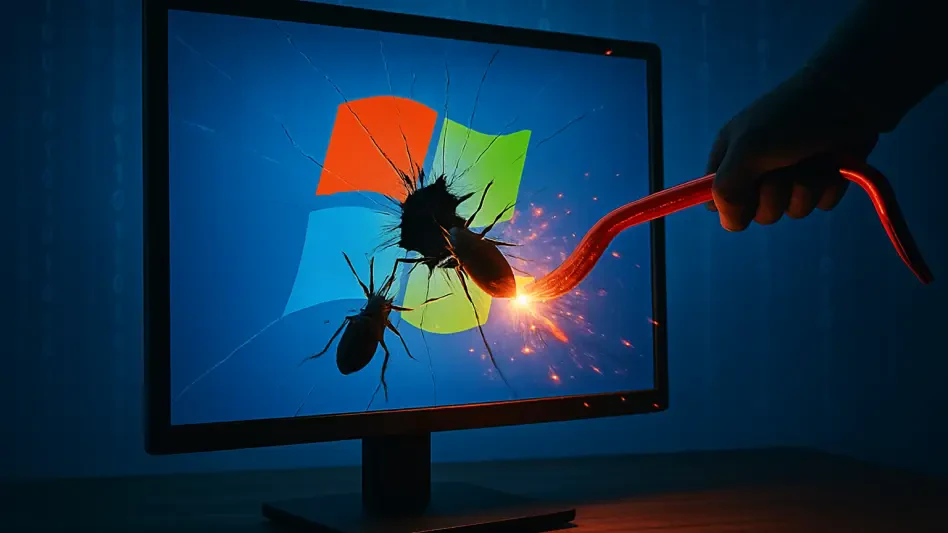In an era where digital security is paramount, the recent uncovering of a zero-day vulnerability in Cisco’s Adaptive Security Appliance (ASA) and Firepower Threat Defense (FTD) platforms has raised urgent concerns across the cybersecurity landscape, threatening the integrity of network infrastructure worldwide. Identified as CVE-2025-20333, this critical flaw, carrying a near-perfect severity score of 9.9 on the CVSS scale, has been actively exploited by sophisticated threat actors in a campaign known as ArcaneDoor, highlighting the evolving tactics of state-sponsored adversaries targeting the very devices designed to protect organizations. For those tasked with safeguarding digital assets, or anyone keen to grasp the gravity of modern cyber threats, this issue serves as a stark reminder of the vulnerabilities lurking within trusted systems. The exploitation of such a flaw, disclosed in September of this year, underscores a chilling reality: even the most relied-upon security tools can be turned into weapons in the hands of determined attackers. This article aims to dissect the technical underpinnings of this vulnerability, explore the intricacies of the associated campaign, and assess the broader implications for global cybersecurity. As the digital realm faces increasingly complex challenges, understanding this threat is not just relevant—it’s essential for building resilient defenses against a new breed of cyber warfare.
Unpacking the Critical Vulnerability in Cisco Systems
The heart of this cybersecurity crisis lies in CVE-2025-20333, a buffer overflow vulnerability embedded within the VPN web server component of Cisco ASA and FTD software. This flaw enables authenticated attackers to craft malicious HTTP requests that, when processed, allow the execution of arbitrary code with root privileges, effectively granting complete control over the affected device. With a CVSS score of 9.9, the severity of this issue cannot be overstated, as it stems from a fundamental failure to properly validate user input—a coding oversight with potentially devastating consequences. Primarily impacting legacy Cisco ASA 5500-X series devices, many of which operate on outdated software versions, this vulnerability exposes a critical weak point in network perimeter defenses. These systems, often beyond their end-of-support timelines, lack contemporary safeguards like Secure Boot, making them particularly susceptible to exploitation. The danger lies not just in the flaw itself but in the strategic importance of the devices it affects, as they are meant to serve as the first line of defense against external threats.
Compounding the threat is the chaining of CVE-2025-20333 with another flaw, CVE-2025-20362, which circumvents authentication mechanisms. This combination creates a lethal exploit path, allowing attackers to access restricted endpoints without valid credentials and escalate their control to the highest privilege level. Unlike isolated vulnerabilities, this pairing transforms a serious risk into an unauthenticated remote code execution scenario, where no prior access is needed to initiate an attack. The implications are profound, as attackers can bypass traditional security barriers and gain a foothold directly at the network’s edge. For organizations relying on these systems to protect sensitive data or critical operations, this exploit chain represents a nightmare scenario, undermining trust in the very infrastructure meant to secure their environments. The technical sophistication required to leverage these flaws also suggests that the perpetrators possess deep knowledge of Cisco’s architecture, raising the stakes for defenders tasked with mitigating such advanced threats.
Inside the ArcaneDoor Campaign and Its Origins
The exploitation of these critical vulnerabilities is tied to the ArcaneDoor campaign, a sophisticated operation attributed to a China-aligned state-sponsored group tracked as UAT4356 or Storm-1849. Known to have been active for at least a year prior to this incident, this group has a history of targeting government entities and critical infrastructure sectors with precision and intent. Their latest activities, observed since May of this year, mark a significant evolution from earlier efforts, showcasing an enhanced ability to develop custom tools and exploit zero-day flaws for maximum impact. The focus on network perimeter devices like Cisco ASA systems reflects a deliberate strategy to compromise the foundational elements of an organization’s security posture. By infiltrating these gateways, attackers gain visibility into network traffic and the potential to manipulate configurations, setting the stage for deeper incursions or long-term espionage.
Central to the campaign are two advanced malware families: RayInitiator and LINE VIPER. RayInitiator functions as a multi-stage bootkit embedded at the firmware level, ensuring persistence by modifying the device’s bootloader to survive reboots and software upgrades. LINE VIPER, on the other hand, operates as a user-mode shellcode loader, facilitating encrypted communications and enabling command execution through unconventional methods such as crafted ICMP packets or WebVPN sessions. These tools demonstrate a remarkable level of technical expertise, allowing the attackers to maintain control while evading standard detection mechanisms. The strategic targeting of legacy hardware, often still in use despite obsolescence, further amplifies the campaign’s effectiveness, as many organizations have delayed necessary upgrades. This calculated approach not only exploits technical weaknesses but also capitalizes on systemic delays in infrastructure modernization, posing a severe challenge to global cybersecurity efforts.
Dissecting the Attack Mechanics and Evasion Tactics
The attack methodology employed in this campaign begins with exploiting CVE-2025-20362 to bypass authentication, granting unauthorized access to restricted URL endpoints on the targeted Cisco devices. This initial foothold is then leveraged to exploit CVE-2025-20333, achieving remote code execution with root privileges and allowing attackers to take full control of the system. Post-exploitation, the deployment of RayInitiator ensures long-term persistence by embedding malicious code at the firmware level, rendering standard remediation efforts—such as system reboots or factory resets—ineffective. This deep-level compromise means that even diligent security teams may struggle to remove the threat without replacing the hardware or reflashing the firmware, a process that is often complex and resource-intensive. The technical sophistication of this attack chain underscores the attackers’ intimate understanding of the target systems and their ability to exploit architectural weaknesses for sustained access.
Beyond persistence, the attackers employ a range of anti-forensic and evasion techniques to obscure their activities and hinder investigations. Tactics include disabling logging functions to eliminate audit trails, selectively suppressing syslog messages to hide critical alerts, and intentionally crashing devices during forensic analysis to corrupt evidence. LINE VIPER further complicates detection by intercepting and modifying administrator commands, concealing malicious actions, and triggering delayed reboots to clear memory-resident components. These measures reveal a profound grasp of defensive operations, as the attackers anticipate and counteract standard incident response protocols. For security professionals, this creates an uphill battle in identifying the scope of a breach, as traditional indicators of compromise are either absent or deliberately obscured, necessitating advanced threat hunting and external monitoring to uncover hidden activities.
Widespread Impact on Critical Infrastructure
The ramifications of this zero-day exploitation extend far beyond individual organizations, striking at the heart of critical infrastructure and government networks worldwide. Compromised Cisco ASA devices, originally deployed as trusted perimeter defenses, become liabilities when attackers gain root access, enabling them to intercept sensitive traffic, alter security configurations, or use the devices as launchpads for lateral movement within a network. This is particularly concerning for sectors like energy, transportation, and healthcare, where these systems often protect vital operations and data. The strategic importance of such devices means that a breach can erode confidence in an organization’s entire security framework, potentially exposing vulnerabilities that adversaries can exploit for espionage, disruption, or other malicious purposes. The scale of the impact is amplified by the widespread use of these legacy systems, many of which remain in service despite known risks.
The global nature of the threat has not gone unnoticed, prompting swift and coordinated responses from cybersecurity authorities across multiple nations. On September 25 of this year, the U.S. Cybersecurity and Infrastructure Security Agency (CISA) issued an emergency directive mandating federal agencies to identify vulnerable devices, apply available patches, and disconnect systems that cannot be secured. Parallel efforts by agencies in the UK, Canada, and Australia have included detailed malware analysis and public advisories, reflecting a unified stance against the escalating danger. This international collaboration highlights the recognition that such threats transcend borders, requiring collective action to mitigate risks and share intelligence. However, the response also reveals challenges, as the persistence of firmware-level threats means that patching alone may not fully neutralize the danger, leaving some organizations grappling with difficult decisions about infrastructure replacement or enhanced monitoring.
Key Lessons for Bolstering Network Security
This incident serves as a critical wake-up call for organizations to reassess their approach to network defense, particularly in light of adversaries who can weaponize security appliances themselves. A primary takeaway is the inadequacy of relying solely on perimeter-based protections, as demonstrated by the ease with which attackers turned Cisco ASA devices into attack vectors. Adopting a defense-in-depth strategy is imperative, incorporating layered safeguards that assume a breach will occur and focus on limiting its impact through internal segmentation, robust access controls, and continuous monitoring. Such an approach shifts the mindset from prevention alone to resilience, ensuring that even if an attacker gains entry, their ability to cause widespread harm is curtailed. Additionally, the importance of external traffic analysis and anomaly detection cannot be overstated, especially when attackers disable device logs to cover their tracks, rendering traditional monitoring tools ineffective.
Another vital lesson lies in the urgent need for infrastructure modernization and proactive maintenance. Legacy Cisco ASA 5500-X series devices, many nearing or past their end-of-support dates, lack essential security features like Secure Boot or Trust Anchor, making them prime targets for persistent threats like firmware-based malware. Organizations must prioritize replacing outdated hardware and ensuring that internet-facing systems are patched promptly to close known vulnerabilities before they can be exploited. Beyond hardware, fostering a culture of rapid response and collaboration—both within organizations and across international partners—is essential to counter state-sponsored threats of this magnitude. By learning from this breach, the cybersecurity community can push for systemic changes, advocating for resources and policies that address the root causes of such vulnerabilities, from coding practices to lifecycle management of critical devices.
Moving Forward with Enhanced Cyber Defenses
Reflecting on the exploitation of CVE-2025-20333 within the ArcaneDoor campaign, it became evident that state-sponsored actors had reached new heights of sophistication, targeting the foundational elements of network security with tailored exploits and persistent malware. The international response, marked by emergency directives and cross-border cooperation, showed a commendable effort to contain the damage, though it also exposed gaps in timely detection and the limitations of standard remediation against firmware-level threats. The profound impact on critical infrastructure underscored how a single flaw could ripple across industries, eroding trust in essential security tools. Looking ahead, actionable steps emerged as crucial: organizations needed to prioritize layered defenses, invest in modern hardware with advanced security features, and enhance external monitoring to detect subtle anomalies. Global collaboration had to strengthen, ensuring shared intelligence and rapid response mechanisms kept pace with evolving threats. This incident, while alarming, offered a blueprint for future resilience, urging a shift from reactive fixes to proactive strategies that could safeguard digital environments against adversaries who continually adapted their tactics.








